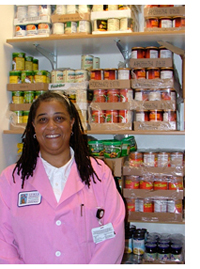| Sun | Mon | Tue | Wed | Thu | Fri | Sat |
|---|---|---|---|---|---|---|
| 1 | 2 | 3 | 4 | 5 | ||
| 6 | 7 | 8 | 9 | 10 | 11 | 12 |
| 13 | 14 | 15 | 16 | 17 | 18 | 19 |
| 20 | 21 | 22 | 23 | 24 | 25 | 26 |
| 27 | 28 | 29 | 30 | 31 |
CATEGORIES
RECENT ENTRIES
BLOG ROLL
Beyond patients
While their children are treated at Comer Children's Hospital, some families go without food. Medical students established a program to help.
By Jason Kelly
Hospital food has a bad reputation, but it’s better than nothing—and that’s not just a figure of speech. Some families of patients at Comer Children’s Hospital do not have the means to eat. They go hungry while their sick kids undergo treatment. “It has serious consequences on the families’ ability to contribute as fully as they would like to their children’s care,” says medical student Robert Stern.

Stern heard about the problem two years ago as part of the Pritzker School of Medicine’s health-care disparities course. Stacy Lindau, AM’02, presented her wide-ranging South Side Health and Vitality Studies and mentioned the Comer problem. It sounded like an issue worth exploring for a class research project.
Along with classmate Dan Thorngren, Stern organized the Comer Food Project, one of several student programs that have emerged from the course to address inequality in medical care. Monica Vela, MD’93, who developed the health-care disparities curriculum, liked their idea but didn’t think it would work. “It’s too difficult; the red tape is too much,” she thought. “Why would the nurses and social workers want extra work to do?”
To navigate the hospital bureaucracy, the students felt they had to emphasize their enthusiasm for more than just a good grade: “to really demonstrate that, although we are students, we’re committed enough to the project to see it through and make it the best it can be,” Stern says. Working with Comer chaplain Karen Hutt, the students found ample support from the staff to establish the program.
After a few months of planning—with $1,000 from a community organization, can openers from Whirlpool, and paper bags from Whole Foods—they stocked a closet in the Comer chapel with food from the Greater Chicago Food Depository. Distribution began in February 2010 with four to five bags per week.
Since then the project has grown, with $7,000 from the hospital and the University’s Urban Health Initiative, serving 625 families in 15 months. That’s about ten percent of the families at Comer, Stern says, “but if you look at the rates of food insecurity on the South Side, the numbers are much higher than ten percent.”
That tells Stern the program has to increase its reach at the hospital. Determining who receives food is mostly a matter of intuition and observation. “We know we’re missing people,” Stern says, so the group is working on a short survey that nurses or social workers can incorporate into discussions with families to identify those in need.
A first-year Pritzker requirement, the health-care disparities course where the Comer Food Project originated encourages students to develop solutions to problems that afflict poor communities. Mammography access and nutrition education are among the other programs that students have created. To Stern, the importance of the course comes from its emphasis beyond the science of medicine.
“It says that there’s more to understanding health than the disease process,” he says. “We can be the best doctors we can at curing disease processes, but that, in and of itself, is not going to bring health to the communities we’re serving.”
Photo of Karen Hutt inside the food storage closet is courtesy Pritzker Pulse.
June 17, 2011
